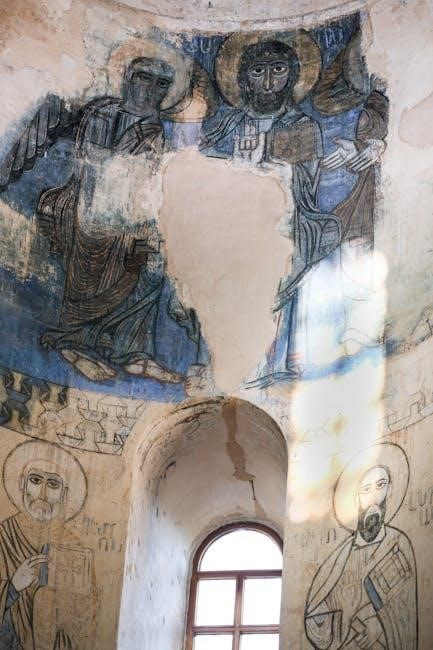The Bible’s history spans over 1,500 years, involving more than 40 authors and key events like its translation into English and the impact of printing technology. Ancient manuscripts from the 1st-6th centuries AD, such as papyri, serve as foundational sources. The evolution of the Bible, from the Old Testament to the New Testament, highlights its significance and enduring influence across civilizations.
1.1 Overview of the Bible’s Historical Significance
The Bible is the most influential book in human history, shaping literature, art, and Western civilization. Its narratives, from creation to redemption, have inspired countless works of art, literature, and music. The Bible’s historical significance extends beyond religion, influencing law, morality, and education. It has been a source of inspiration for social justice movements and a cornerstone of cultural identity. The Bible’s impact is evident in its translation into thousands of languages and its role in shaping societies globally. Its stories, such as the Fall of Eden and the Exodus, have become cultural touchstones. The Bible bridges ancient and modern times, offering timeless wisdom and sparking ongoing theological and philosophical debates. Its influence remains unparalleled, making it a foundational text for understanding Western history and culture.
1.2 The Bible as a Historical Document
The Bible is a rich historical document, offering insights into the ancient Near East and the 1st-century CE world. It contains records of events, cultures, and societies that shaped the course of history. Archaeological discoveries, such as ancient papyri and codices, corroborate many biblical accounts, providing a tangible link to the past. The Old Testament details the history of Israel, while the New Testament contextualizes the life of Jesus within the Roman Empire. These narratives are intertwined with historical events, making the Bible a valuable resource for understanding ancient civilizations. Its historical authenticity is supported by textual evidence and scholarly research, reinforcing its credibility as a document of antiquity. The Bible’s historical content remains a vital area of study, bridging faith and academia in exploring the past.

The Composition of the Bible
The Bible’s composition spans over 1,500 years, involving more than 40 diverse authors who wrote in multiple languages. It is divided into the Old and New Testaments.
2.1 The Old Testament: Key Books and Authors
The Old Testament, comprising 39 books, is foundational to both Judaism and Christianity. Its texts span from creation narratives in Genesis to prophetic writings like Isaiah and Ezekiel. Key authors include Moses, traditionally credited with the Torah, and figures like David, who contributed Psalms. Prophets such as Jeremiah and Ezekiel authored major sections, addressing Israel’s history and divine covenant. The Old Testament also includes wisdom literature, such as Proverbs and Job, exploring human nature and morality. These texts, written over centuries, reflect diverse genres and theological themes, shaping the spiritual and cultural heritage of ancient Israel.
2.2 The New Testament: Formation and Content
The New Testament, written primarily in Greek, emerged between 50-150 CE and consists of 27 books. Its formation began with oral traditions about Jesus’ life, teachings, death, and resurrection, which were later compiled into written texts. The four Gospels—Matthew, Mark, Luke, and John—form the core, each offering unique perspectives on Jesus’ ministry. The Epistles of Paul, written earlier than the Gospels, address early Christian communities and theological issues. Other texts include general epistles, such as James and Peter, and the Book of Revelation. The New Testament reflects the early Christian movement’s diversity and unity, blending Jewish and Greco-Roman influences. Its content shaped Christian theology, ethics, and practices, making it a cornerstone of Christian faith and identity.

The Formation of the Biblical Canon
The biblical canon emerged through centuries of recognizing authoritative texts by early communities, with criteria like apostolic origin shaping its development and stabilization into the Bible as we know it today.
3.1 The Hebrew Bible and Its Canonization
The Hebrew Bible, or Tanakh, underwent a gradual canonization process over centuries. The earliest texts, including the Torah, were recognized for their divine authority and historical significance. By the 2nd century BCE, the Prophets and Writings were added, with the Council of Jamnia traditionally marking the closure of the Hebrew canon around 70-100 CE. This process involved debates over inclusion, such as the Book of Ecclesiastes, ensuring only texts deemed sacred and authoritative were included. The canonization reflected the evolving religious and cultural identity of the Jewish community, establishing the foundation for both Jewish and Christian traditions. This historical process highlights the careful selection and preservation of texts that shaped the Hebrew Bible as it is known today.
3.2 The Christian Bible: Development and Recognition
The Christian Bible’s development began with the early church recognizing texts as authoritative, including the Old Testament and newly written apostolic works. The New Testament emerged gradually, with its canon formalized by church councils in the 4th century, such as Nicaea (325 CE) and Hippo (393 CE). These councils established the boundaries of sacred scripture, distinguishing canonical texts from apocryphal ones. The process of recognition was influenced by theological debates and the need for unity across diverse Christian communities. The Protestant Reformation further shaped the Christian Bible by rejecting certain books, leading to the distinction between Catholic and Protestant canons. This historical journey highlights the complex interplay of faith, tradition, and authority in shaping the Christian Bible as it is recognized today.

Translations of the Bible
The Bible has been translated into numerous languages, with key versions including the Septuagint, Vulgate, King James Version, and modern translations, enhancing its global accessibility and influence.
4.1 Early Translations: The Septuagint and Vulgate
The Septuagint, produced around 250 BCE in Alexandria, was the first major translation of the Hebrew Bible into Greek, enabling wider dissemination among Hellenistic Jews and early Christians. The Vulgate, completed by Jerome in 405 CE, translated the Bible into Latin, becoming the authoritative text for the Catholic Church. These early translations bridged linguistic and cultural gaps, ensuring the Bible’s accessibility and influence across diverse populations. The Septuagint’s accuracy and the Vulgate’s enduring authority shaped biblical scholarship and liturgical practices, leaving a lasting legacy in Christian tradition and textual preservation. These translations remain foundational in understanding the Bible’s historical journey and its role in shaping global religious and cultural landscapes. Their impact underscores the importance of linguistic adaptation in spreading sacred texts.
4.2 The King James Version and Its Impact
The King James Version (KJV), published in 1611, was commissioned by King James I to resolve disputes over various English translations. It became the standard Bible for centuries, shaping religious practices, literature, and culture. Its influence extends to art and Western society, with its phrases embedded in everyday language. The KJV’s clarity and poetic style made it accessible, fostering literacy and theological understanding. Its role in spreading Protestant ideals during the Reformation was significant. Despite modern translations, the KJV remains a foundational text, reflecting its enduring legacy in Christianity and global culture. Its impact highlights the transformative power of biblical translation in shaping societies and individual beliefs, ensuring its continued relevance in religious and academic contexts. The KJV’s historical significance remains unparalleled in the history of biblical texts;
4.3 Modern Translations and Their Significance
Modern Bible translations, such as the New International Version (NIV) and the English Standard Version (ESV), have made the text more accessible to contemporary readers. These versions aim to balance linguistic accuracy with readability, ensuring the Bible remains relevant in a changing world. Advances in biblical scholarship and archaeological discoveries have informed these translations, offering fresh insights into the original texts. Digital formats, such as PDFs and online resources, have further expanded accessibility, allowing global audiences to engage with the Bible in new ways. Modern translations also cater to diverse linguistic and cultural needs, fostering a deeper understanding of scripture. Their significance lies in their ability to preserve the Bible’s timeless message while adapting to the demands of modern communication, ensuring its continued influence in an evolving society. This adaptability underscores the Bible’s enduring relevance in the digital age.
Historical Context of Biblical Texts
The Old Testament originates from the ancient Near East, while the New Testament is set in the 1st century CE, reflecting distinct cultural and historical settings.
5.1 The Ancient Near East and the Old Testament
The Old Testament is deeply rooted in the cultural and historical landscape of the Ancient Near East, a region that includes modern-day Middle East and North Africa. This period, spanning from around 1200 BCE, saw the rise of civilizations like the Egyptians, Babylonians, and Assyrians, whose influences shaped the Israelites’ worldview. Key events, such as the Exodus from Egypt and the conquest of Canaan, are central to the Old Testament narrative. The Israelites’ interactions with these powerful empires often led to cultural exchange and conflict, which are reflected in biblical accounts. The legal codes, prophetic writings, and wisdom literature of the Old Testament also show parallels with other Ancient Near Eastern texts, highlighting shared themes and motifs. Understanding this historical context is essential for interpreting the Old Testament’s themes of monotheism, covenant, and divine justice.
5.2 The 1st Century CE: Context for the New Testament
The 1st century CE was a transformative period for the New Testament, shaped by the Roman Empire’s dominance and Jewish religious traditions. Politically, the Roman Empire under Emperor Tiberius (14–37 CE) imposed stability but also oppression, fostering resentment among Jewish populations. Religiously, Judaism was diverse, with groups like the Pharisees, Sadducees, and Zealots influencing the cultural landscape. This backdrop is crucial for understanding the life of Jesus and the early Christian movement.
Socio-economically, the region faced disparities between urban elites and rural peasants, while Jewish nationalism simmered. The New Testament reflects these tensions, as well as the blending of Greek and Latin cultures. Events like the Crucifixion and the destruction of the Jerusalem Temple in 70 CE marked this era’s turmoil, shaping the New Testament’s themes of redemption and hope.

The Preservation of Biblical Manuscripts
The preservation of biblical manuscripts involved meticulous copying by scribes, transitioning from papyri to codices, ensuring the text’s integrity and enduring influence across centuries.
6.1 Ancient Manuscripts: Papyri and Codices
Ancient manuscripts, such as papyri and codices, are fundamental to understanding the preservation of biblical texts. Papyri, made from papyrus reeds, were commonly used in the 1st-6th centuries AD for recording religious and literary works. Codices, bound books of parchment or vellum, emerged later and offered greater durability and convenience. Early biblical manuscripts, including fragments like P52, provide critical insights into the text’s transmission and accuracy. Scribes meticulously copied these manuscripts, ensuring their survival across centuries. The transition from papyri to codices marked a significant shift in how biblical texts were preserved and disseminated. These ancient materials remain vital for scholars studying the history and authenticity of the Bible, offering a tangible connection to the past. Their discovery and analysis continue to illuminate the evolution of biblical texts and their enduring influence on religious and cultural traditions.
6.2 The Role of Monasteries in Preserving Biblical Texts
Monasteries played a pivotal role in preserving biblical texts during the Middle Ages. Monks meticulously copied manuscripts by hand in scriptoriums, ensuring the survival of sacred writings. Their dedication maintained the integrity of biblical texts, safeguarding them for future generations. The monastic tradition of copying manuscripts was crucial before printing technology, making monasteries central to textual preservation. This labor-intensive process involved scribes who carefully transcribed each word, often illuminated with intricate artwork. Monasteries also served as repositories for ancient manuscripts, protecting them from destruction. Their efforts were vital in maintaining the Bible’s availability and accuracy, ensuring its enduring influence across centuries. The preservation work of monasteries remains a cornerstone in the history of biblical texts, underscoring their indispensable contribution to religious and cultural heritage.

The Impact of Printing Technology
Printing technology revolutionized the Bible’s dissemination, enabling mass production and widespread accessibility, which significantly influenced religious and cultural movements across the world.
7.1 The Gutenberg Bible and Its Legacy
The Gutenberg Bible, printed around 1455, was the first major book produced using movable-type printing technology, revolutionizing biblical dissemination. This Latin Vulgate edition, comprising 1,286 pages, marked a pivotal moment in history, enabling mass production of the Bible. Johannes Gutenberg’s innovation not only made the text more widely accessible but also contributed to standardization, reducing transcription errors. The Gutenberg Bible’s legacy lies in its role as a cornerstone of the printing revolution, facilitating the spread of knowledge and influencing the Protestant Reformation. Its impact extended beyond religion, shaping education, literature, and communication. This groundbreaking achievement remains a testament to the transformative power of technology in preserving and sharing sacred texts, ensuring the Bible’s enduring influence across centuries.
7.2 Mass Production and Accessibility of the Bible
The advent of mass production techniques in the 19th century further democratized access to the Bible. Steam-powered presses and mechanized binding enabled rapid production, making the Bible more affordable and widely available. This era saw the rise of societies like the British and Foreign Bible Society, which distributed millions of copies worldwide. The King James Version became a staple, while new translations emerged to cater to diverse linguistic and cultural needs. Improved transportation networks facilitated global distribution, ensuring the Bible reached remote regions. This accessibility not only boosted literacy rates but also empowered individuals to engage directly with the text, fostering personal and communal religious practices. The mass production of the Bible remains a cornerstone of its enduring influence, bridging spiritual and societal transformation across generations.

Key Figures in Biblical History
Key figures like Martin Luther and William Tyndale played pivotal roles in shaping the Bible’s history through translation and reform, enabling widespread accessibility and theological transformation.
8.1 Biblical Authors and Their Contributions
The Bible’s composition involved over 40 authors, including prophets, poets, and apostles, whose writings spanned centuries. Key figures like Moses, traditionally linked to the Torah, and the prophets Isaiah and Jeremiah, shaped the Old Testament’s theological core. In the New Testament, authors such as Matthew, Mark, Luke, and John chronicled the life of Jesus, while Paul’s epistles became foundational for Christian theology. Other contributors, like King David and Solomon, added poetic and wisdom literature. Each author’s unique perspective and historical context enriched the biblical narrative, creating a diverse yet cohesive text. Their works laid the groundwork for religious faith and cultural traditions, making their contributions indispensable to the Bible’s enduring legacy.
8.2 Scholars and Reformers: Luther, Tyndale, and Others
Martin Luther, a pivotal figure in the Protestant Reformation, challenged Church practices and translated the Bible into German, making it accessible to laypeople. William Tyndale, an English scholar, risked his life to produce the first English translation of the New Testament from Greek, laying the groundwork for later translations like the King James Version. John Wycliffe, often called the “Morning Star of the Reformation,” initiated earlier efforts to translate the Bible into English. These scholars, alongside others, played crucial roles in democratizing Scripture and fostering theological debate. Their contributions not only shaped the Bible’s accessibility but also influenced the development of Western spirituality and literacy, leaving a lasting legacy in biblical history and interpretation.

The Bible’s Influence on Civilization
The Bible has profoundly shaped literature, art, and culture, inspiring countless works across centuries. Its themes and narratives remain foundational to Western society, influencing moral, legal, and cultural frameworks globally.
9;1 The Bible in Literature and Art
The Bible has profoundly influenced literature and art throughout history. Works like John Milton’s Paradise Lost and Dante’s Divine Comedy draw heavily from biblical themes. In art, masterpieces by Michelangelo and Raphael depict biblical scenes, showcasing its enduring inspiration. The Bible’s narratives and symbolism continue to resonate in modern literature and visual arts, reflecting its deep cultural impact and timeless relevance to human experience.
9.2 The Bible’s Role in Shaping Western Society
The Bible has played a foundational role in shaping Western society, influencing law, morality, and culture. Its teachings on justice, compassion, and morality have shaped legal systems and ethical frameworks. The concept of human dignity, rooted in the biblical idea of humans being created in God’s image, has profoundly impacted human rights movements. Education systems in the West were historically shaped by biblical literacy, with many universities originating from religious institutions. Additionally, the Bible’s themes of justice and equality inspired movements like abolition and civil rights, with figures like Martin Luther King Jr. drawing heavily from its teachings. Its influence extends to social justice, underscoring the responsibility to care for the marginalized. Thus, the Bible remains a cornerstone of Western societal values and cultural identity.

Controversies and Debates
The Bible has faced controversies regarding its violent content, theological debates, and historical accuracy, with accounts like Adam and Eve sparking intense discussions among scholars and believers.
10.1 Theological Debates and Interpretations
Theological debates surrounding the Bible often focus on its interpretation and authority. Scholars and believers alike grapple with its teachings, leading to diverse perspectives on topics like divine sovereignty and human free will. The Bible’s portrayal of violence, such as in the Old Testament, has sparked intense discussions about its moral implications. Additionally, debates over the historicity of events, such as the creation story in Genesis, highlight the tension between scientific understanding and religious belief. These discussions reflect the complex and multifaceted nature of the Bible, underscoring its enduring relevance and the challenges of interpreting ancient texts in modern contexts.
10.2 Historical Criticism and the Bible
Historical criticism of the Bible involves analyzing its texts as historical documents, seeking to understand their origins, authorship, and social contexts. Scholars examine textual layers, contradictions, and the evolution of ideas within the Bible. This approach often challenges traditional views, highlighting the diversity of perspectives within the text. For instance, the Old Testament’s historical narratives are studied in light of archaeological findings, while the New Testament’s accounts are analyzed within the political and religious climate of 1st-century Palestine. Historical criticism also explores the role of editors and redactors in shaping the final form of biblical books. While this method has enriched biblical understanding, it has also sparked debates among scholars and believers about the Bible’s authority and interpretation.

The Bible in the Digital Age
The Bible is now widely accessible in digital formats, including PDF versions and online resources, enabling global access and fostering deeper engagement with its teachings and history.
11.1 PDF Versions and Online Resources
The Bible’s history is widely available in digital formats, including PDF versions and online resources, offering comprehensive insights into its historical development and cultural impact; Resources like “All About History ⎯ Story of the Bible.pdf” provide detailed overviews, while “The Cambridge History of the Bible” offers scholarly essays on its origin, canon, and translation. These digital tools include timelines, bibliographies, and analyses of key events, such as the evolution of biblical manuscripts and the influence of printing technology. Online platforms also feature works by scholars like Philip W. Comfort, exploring the Bible’s authority and significance. Such resources enable accessible and in-depth study of the Bible’s history, catering to both academic and personal interests. They highlight the integration of ancient texts with modern technology, ensuring the Bible’s enduring relevance in the digital age.
11.2 The Future of Biblical Studies in the Digital Era
The digital age is revolutionizing biblical studies, offering unprecedented access to resources and innovative tools for scholarship. Advanced technologies like AI and machine learning are enhancing manuscript analysis and linguistic studies. Virtual reality and interactive platforms are creating immersive experiences for exploring biblical history. Online databases and collaborative projects are fostering global cooperation among scholars. The rise of digital editions, such as PDF versions of historical texts, ensures that rare manuscripts are preserved and widely accessible. These developments are transforming how the Bible is studied, making it more engaging and inclusive. As technology evolves, biblical studies will continue to integrate new methods, promising a future of deeper understanding and broader engagement with the Bible’s rich history and teachings.
